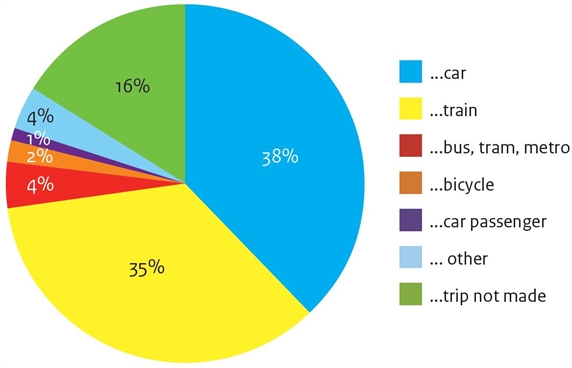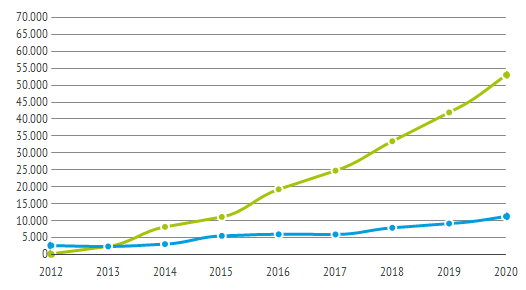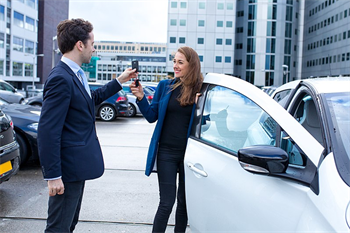Fact sheet Car sharing
Car sharing offers consumers a paid shared car service offered by a professional provider (business-to-consumer) or a private individual (consumer-to-consumer) via an intermediary organisation[1]. Lending a car to family, friends or acquaintances, or hiring a car, are not part of this.
As part of 'Green Deal Autodelen II' (Green Deal Car sharing II), various businesses, the government and NGOs expressed their ambition to have a network of 100,000 shared cars available in 2021 and to increase the number of car-sharers to 700,000. The number of shared cars in the Netherlands has increased considerably in recent years. In 2015, there were 14,000 shared cars in the Netherlands. In 2021, there were 971,000 car-sharers and 87,825 shared cars. This strong growth is mainly due to the rapid development of consumer-to-consumer services. Car sharing is growing fastest in (very) urban areas, with Utrecht and Amsterdam as the frontrunners. One example of municipal policy on car sharing has been developed in the case study Car sharing in Wageningen.
Accessibility effects
Shared car trips are often used to replace the use of a private, borrowed or rented car (38%) or to replace public transport (35%), as shown in the pie chart. Several international studies show that car sharing actually reduces car ownership and the distances travelled by car[1]. This also applies to the Netherlands.

In 2015, the Netherlands Institute for Transport Policy Analysis (KiM) conducted a survey among 363 motorists, from a representative panel put together by TNS NIPO. On average, the respondents drove 9,100 km per year by car. When they started car sharing, they still drove an average of 7,500 km per year. That is an average reduction of 1,600 km per year. 40% of all trips by shared car were made at the weekend, only 13% during the rush-hour, and 10% for commuting. Usually, these were medium to long distances: half of the shared car journeys were longer than 50 km.
Long-term effects
In addition to the fact that the distances driven per driver were decreasing among shared car users, there was also a decrease in overall car use among car-sharers. Results from the evaluation programme 'The shared car in the Netherlands' confirm this. Four systems were evaluated in two evaluation rounds. In all cases, the use of the car decreased: a reduction of 43% in the first tranche and 15% in the second tranche. In the longer term, car-sharers were more likely to use a bicycle (+5% and +10%), train (+7% and +16%) and urban transport (+5% and +12%).
For this reason, it is assumed that car sharing is contributing to changing the mobility culture. In-depth interviews with car-sharers in the United Kingdom showed that car-sharers have started to use the car less and travel more often on foot, bicycle or public transport. One of the reasons for this could be that the shared car has made travellers more aware of mobility. This is because car sharing requires planning, which means that the choice of transport is well considered and people are more likely to choose another option. Over time, car-sharers will also learn about the advantages of other means of transport, which will reduce their use of the shared car.
Sustainability effects
A reduction of 1,600 kilometres driven per year resulting from a decrease in car ownership is equivalent to a saving of 175-265 kg CO2 per year, per car sharing household. As a rule, one shared car replaces four to eight private cars. One shared car provides a space saving of 36-38 m2 This space saving can reduce the cost of parking facilities in new construction projects and provide a solution for space shortages in busy cities. Also, car sharing instead of (2nd) car ownership contributes to objectives for a circular economy.
![]()

Variables affecting effects
A number of project features affect the effects of car sharing. These variables are:
- A local traffic and transport policy contributes to the growth of car sharing systems. This could include a parking policy tailored to the car sharing scheme, such as parking permits for shared cars and higher parking charges for private cars.
- Shared car users attach great value to a limited walking distance to the shared car. They see it as a benefit that the car is available nearby. For this reason, the size and variety of shared cars are important, in combination with a high building density. As a result, many people have access to a shared car at a short distance.
- Another point concerns the convenience and flexibility of the system. It should be accessible and not too expensive. It should not take too much effort to settle financial transactions and there should be an organisation that takes care of all peripheral issues: breakdowns, fines, maintenance, and so on.
- The co-ordination and integration of the car sharing system with public transport is also a factor that can stimulate its use. Examples include parking ranks for shared cars at various stations and public transport stops or joint marketing by public transport and car sharing companies.
- It may be important to introduce the car sharing system as a social enterprise or co-operative. In that case, people feel co-owners and are more involved in the functioning and quality of the system.
- Car-sharers are going to cycle more and use public transport. It is therefore important to respond to this growth properly and in a timely manner.
- Finally, there are opportunities in sharing business cars through a pooling system. Municipalities can encourage car sharing in companies through employers.
Costs
car sharing is relatively inexpensive for the government. The market develops the products and people share cars between them. There is no need for infrastructural interventions or subsidies as in the case of public transport. It does, however, require the necessary alignment with policy development. Tips for this can be found in the publication 'De rode loper uit voor autodelen' (The red carpet out for car sharing)[2].
A qualitative cost-benefit analysis shows that both users and society are net beneficiaries[3]. The same analysis showed that the government incurs costs particularly when it wants to stimulate car sharing projects. The provinces of Gelderland and North Brabant have a temporary subsidy to specifically stimulate the supply of electric shared cars.
In addition, revenue from purchase tax on cars may decrease as fewer cars will be sold. This will have an effect on the budgets of the national and provincial governments (surcharges). Yet at the social level this does not outweigh the benefits in terms of sustainability, health, urban congestion and land use. So car sharing does not have to cost the government much. However, it requires the necessary co-ordination in the terms of policy development, both local and provincial.
More information
Visit https://autodelen.info/
Sources consulted
- Netherlands Institute for Transport Policy Analysis – Mijn auto, jouw auto, onze auto, 2015
- Autodelen.info (Friso Metz for GreenDeal Autodelen): De rode loper uit voor autodelen
- Nijland, H., Meerkerk, J. & A. Hoen (2015). Effecten van autodelen op mobiliteit en CO2-uitstoot. The Hague: Netherlands Environmental Assessment Agency
- Das, M. Rijkswaterstaat – Autodelen in de versnelling, 2016
- KpVV CROW Autodelen - KpVV Dashboard duurzame en t mobiliteit,
- KpVV CROW - Factsheet Aan de slag met autodelen, 2010
- Dashboard Autodelen CROW 2019
Rules of thumb
- effect on accessibility: an average car sharer drives 1,600 kilometres per year less
- effect on sustainability: 175 - 265 kg CO2 savings per car sharing household per year
- costs: in principle, costs for government are relatively low
